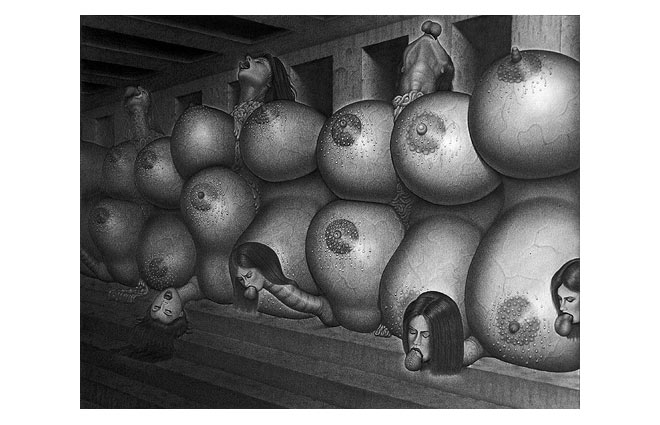
|
|
|

Take the biggest question of all, for example: what is the ultimate nature of reality? We used to think the answer was atoms. Then we learned about the electron and then about the atomic nucleus. Then it became clear that this nucleus was composed of protons and neutrons. Then these particles were discovered to be composed of quarks held together by gluons. And now we’re in trouble. We know these particles follow those strange quantum laws, and the consequences of this lead us towards an extraordinary answer to our very ordinary question.
At heart, quantum theory is about probabilities. No particle has a real existence that we can speak of; we can only express the probability of finding it somewhere. In fact, quantum theory is really about getting access to information.
Information is not an abstract entity. It is always encoded in something physical: a computer’s hard disk, say, or molecules of ink on a page. So if quantum theory is leading us towards the idea that information lies at the heart of reality, this information must be stored somehow in the physical universe.
Faced with such a staggering notion, scientists began to seek out the supporting evidence. And, though it’s very early days, it seems there is some.
{ New Humanist | Continue reading }
photo { Danny Lyon }
ideas, photogs, science |
January 10th, 2013

A drug applied to the ears of mice deafened by noise can restore some hearing in the animals. By blocking a key protein, the drug allows sound-sensing cells that are damaged by noise to regrow. The treatment isn’t anywhere near ready for use in humans, but the advance at least raises the prospect of restoring hearing to some deafened people.
{ Science | Continue reading }
image { Yoshifumi Hayashi }
health, noise and signals, science |
January 10th, 2013

Guy Debord’s first book, Mémoires, was bound with a sandpaper cover so that it would destroy other books placed next to it.
{ Wikipedia | Continue reading }
Mémoires was written, or rather assembled, by Guy Debord and Asger Jorn in 1957. Debord himself often referred to Mémoires as an anti-book. […] The text is entirely composed of fragments taken from other texts: photographs, advertisements, comic strips, poetry, novels, philosophy, pornography, architectural diagrams, newspapers, military histories, wood block engravings, travel books, etc. Each page presents a collage of such materials connected or effaced by Jorn’s structures portantes, lines or amorphous painted shapes that mediate the relationships between the fragments.
{ via David Banash | Continue reading }
books, visual design |
January 10th, 2013

We tested whether eye color influences perception of trustworthiness. Facial photographs of 40 female and 40 male students were rated for perceived trustworthiness. Eye color had a significant effect, the brown-eyed faces being perceived as more trustworthy than the blue-eyed ones.
{ PLOS | Continue reading }
colors, eyes, psychology |
January 10th, 2013

As we age, it just may be the ability to filter and eliminate old information – rather than take in the new stuff - that makes it harder to learn, scientists report.
“When you are young, your brain is able to strengthen certain connections and weaken certain connections to make new memories,” said Dr. Joe Z. Tsien, neuroscientist. It’s that critical weakening that appears hampered in the older brain, according to a study in the journal Scientific Reports. […]
“We know we lose the ability to perfectly speak a foreign language if we learn than language after the onset of sexual maturity. I can learn English but my Chinese accent is very difficult to get rid of. The question is why,” Tsien said.
{ EurekAlert | Continue reading }
photo { Achim Lippoth }
memory |
January 10th, 2013

At this time last year, the price of a frozen, euthanized mouse was 45 cents. But now, that price has nearly doubled. […]
Mice and rats are in high demand as a main food source at a clinic that houses and rehabilitates 4,000 to 5,000 injured, orphaned and displaced wild animals every year.
{ LJ World | Continue reading }
photo { Nico Krijno }
animals, economics |
January 10th, 2013

There are notes and notes, of course: notes to oneself and notes to others; notes taken, made, jotted, and passed. Mash, doctor’s, suicide, and condolence notes. Field, class, and case notes; notes for general circulation; foot and head notes, notes of hand. But it’s the bookish notes that academics care most about, the ones that intervene between the things we read and the things we write. […]
In his 1689 De arte Excerpendi, the Hamburg rhetorician Vincent Placcius described a scrinium literatum, or literary cabinet, whose multiple doors held 3,000 hooks on which loose slips could be organized under various headings and transposed as necessary. Two of the cabinets were eventually built, one for Placcius’s own use and one acquired by Leibniz. It was an early manifestation of the principle that still governs our response to the knowledge explosion: The remedy for the problems created by information technology is more information technology. […]
There’s no evidence that Leibniz made any use of his literary cabinet. Despite his lifelong interest in organizational schemes—he designed one of the earliest book-indexing systems—Leibniz’s note-taking was as disorganized as it was obsessive.
{ Geoffrey Nunberg/The Chronicle of Higher Education | Continue reading }
flashback, ideas |
January 10th, 2013
U.S., haha |
January 10th, 2013

Scientists think that they have the answer to why the skin on human fingers and toes shrivels up like an old prune when we soak in the bath. Laboratory tests confirmed a theory that wrinkly fingers improve our grip on wet or submerged objects, working to channel away the water like the rain treads in car tyres. […]
Wrinkled fingers could have helped our ancestors to gather food from wet vegetation or streams, Smulders adds. The analogous effect in the toes could help us to get a better footing in the rain.
{ Nature | Continue reading }
science, water |
January 9th, 2013

Age-otori (Japanese): To look worse after a haircut
Tingo (Pascuense language of Easter Island): To borrow objects one by one from a neighbor’s house until there is nothing left
Backpfeifengesicht (German): A face badly in need of a fist
{ via The Atlantic | Continue reading }
photo { Mary Ellen Mark }
Linguistics, within the world |
January 9th, 2013

Guns should know where they are and if another gun is nearby. Global positioning systems can meet most of the need, refining a gun’s location to the building level, even within buildings. Control of the gun would remain in the hand of the person carrying it, but the ability to fire multiple shots in crowded areas or when no other guns are present would be limited by software that understands where the gun is being used.
Guns should also be designed to sense where they are being aimed. Artificial vision and optical sensing technology can be adapted from military and medical communities. Sensory data can be used by built-in software to disable firing if the gun is pointed at a child or someone holding a child.
Building software into guns need not affect gun owners’ desire to protect their homes. Trigger control software could be relaxed when the gun is at home or in a car, while other safety features stay on to prevent accidental discharges. Guns used by the police would be exempt from such controls.
{ Jeremy Shane/CNN | Continue reading }
guns, technology |
January 9th, 2013

For decades, consensus among psychologists has held that a group of five personality traits –– or slight variations of these five –– are a universal feature of human psychology. However, a study by anthropologists at UC Santa Barbara raises doubt about the veracity of that five-factor model (FFM) of personality structure as it relates to indigenous populations. […] Studying the Tsimane, an isolated indigenous group in central Bolivia, Michael Gurven, a professor of anthropology at UCSB and lead author of the paper, found they did not necessarily exhibit the five broad dimensions of personality –– openness, conscientiousness, extraversion, agreeableness, and neuroticism. While previous research has found strong support for what experts refer to as the “Big Five” in more developed countries and across some cultures, Gurven and his team discovered more evidence of a Tsimane “Big Two” –– prosociality and industriousness.
{ EurekAlert | Continue reading }
photo { Nadav Kander, Chongqing IV, Sunday Picnic, 2006 }
psychology |
January 9th, 2013

A sense of humor is widely viewed as beneficial for physical health. However, some limited research suggests that humor may actually be related to increased smoking and alcohol consumption because humorous individuals may take a less serious attitude toward substance use. The purpose of the present study was to explore this hypothesis in greater detail in a sample of 215 undergraduate students. […] Overall, these results support the view that a sense of humor may be related to less healthy habits, at least in the domain of substance use.
{ Europe’s Journal of Psychology | Continue reading }
haha, health, psychology |
January 8th, 2013

When a law bans exchanges wanted by everyone directly involved a number of things happen:
1) The exchanges continue;
2) Prices of the banned items rise and wars to control turf begin;
3) New criminals are created, including many people who are ordinary good people (like colored margarine seekers);
4) New enforcement agencies and staff are created;
5) New jails are built and new jailers are trained;
6) Laws, lawyers and lawsuits proliferate;
7) A new branch of law and its practitioners prosper and support further extension and complexification of regulations;
8) A portion of the entire apparatus of enforcement and punishment is progressively corrupted;
9) New agencies and staff are created to discover, eliminate or suppress the corruption;
[…]
It is not enough to simply ban exchanges that have consequences we don’t like. The costs of doing it should be compared with the costs of not doing it.
{ Chicago Boyz | Continue reading }
related { Have We Lost the War on Drugs? | Tide detergent: Works on tough stains. Can now also be traded for crack. }
drugs, economics, law |
January 8th, 2013

The more alcoholic drinks people consume, the more attractive they perceive themselves to be. […]
First, women with high levels of estrogen feel prettier, and second, smoking causes a lowered presence of estrogen in your body. So if you’re a female smoker and want to feel more attractive, boost your estrogen levels and stop smoking. Additionally this hormone helps maintain your female features and is vital to your body’s fertility.
{ United Academics | Continue reading }
photo { Bill Brandt }
guide, hormones, smoking |
January 8th, 2013

Faking emotions is often necessary for both communicating partners. Van Kleef argued that emotional regulation is affected by social norms in society. People regulate their positive or negative emotions instinctively by decreasing or escalating them, as well by managing them or using controlled processes. Therefore, faking is a possible alternative. It is thought that people fake their emotions to mask their genuine feelings, to avoid a painful truth, or in response to social influence such as peer pressure or ex- pectations and to follow social norms. Such influences may cause individuals to fake their emotions simply to make life more comfortable by pleasing others or avoiding social disapproval. […]
Emotions expressed in an interaction may transmit important information to the observer which may be essential for the relationship. Relationships can be classified in terms of their expected benefits. Clark and Mills distinguished between two types of relationships. In the communal type of relationship (between close friends or family members), the interacting partners experience concern for their partner’s wellbeing. Emotional authenticity is important and crucial for the fulfillment of the emotional needs of both parties in the inter- action; it reflects the meaning and the depth of the relationship. On the other hand, exchange relations are those that take place between associates who are together for the purpose of doing business or working (e.g., colleagues). In these cases the other’s emotional well-being may be irrelevant or even a burden. Thus, in exchange relationships people may prefer others to fake emotions rather than display authentic ones.
Our study investigates anger because anger is the most common negative emotion.
{ Interpersona | Continue reading }
art { Francis Bacon, Study for Self Portrait, 1982-84 }
Francis Bacon, psychology, relationships |
January 8th, 2013

Software developed by the FBI and Ernst & Young has revealed the most common words used in email conversations among employees engaged in corporate fraud.
The software, which was developed using the knowledge gained from real life corporate fraud investigations, pinpoints and tracks common fraud phrases like “cover up”, “write off”, “failed investment”, “off the books”, “nobody will find out” and “grey area”.
Expressions such as “special fees” and “friendly payments” are most common in bribery cases, while fears of getting caught are shown in phrases such as “no inspection” and “do not volunteer information”.
{ Computer World | Continue reading }
scams and heists, spy & security, technology |
January 8th, 2013
photogs |
January 7th, 2013






















